Despite identifying as secular for most of my life, I’ve always been a bit jealous of those who have religion. For the past year on the nose I’ve felt untethered. The feeling has likely been brewing for much longer but I couldn’t find the words until there was much less anchoring me to one place. There doesn’t seem to be any purpose in life other than to receive life and give life. Sinking into that feeling is disorienting. It feels like I’m floating into an abyss. Life cannot survive in a void.
The religious must have figured it out. Or at least that’s what I fantasize about- waking up everyday with a purpose. Following a clear set of principles from something bigger than yourself to inform even your most mundane choices. Even if that “something bigger” is a mythical character or a story just to help one fill the void, it sounds much more securing than feeling the void itself.
Lately I’ve been sitting down at my desk trying to write down some principles to guide my life. Coming up with nothing but “I need…. music, nature, good food, community”. Lovely! Not a single principle, just obvious joys of life.
Last week, I was fortunate enough to visit Iceland which included a hike on the Laugavegur Trail. International travel has never been on my “to-do” list until recently when I realized that I was turning 30 without stepping foot outside of the U.S. or Canada. Yes - I mean it, other than for that reason international travel never crossed my mind. Who knows- maybe my fear of flying made me lack the desire. Planning the trip felt like mapping out an abyss. Regardless of what travel blogs I read, maps I outlined, or pictures and videos watched, my brain could not conceptualize the idea of being in a place I had not already set foot in.
As the bus dropped us off at the trailhead in Landmannalaugar, I learned that the abyss was not always black but sometimes tan. Dozens of camel-colored mountain ridges surrounded us in the otherwise flat desert. If you look off into the distance, you may not recognize a single sign of life. Wind liberally sweeps the surface of the mountain walls, making it almost impossible for life to root. The moss that carpets some of the floor is so dry and minimal it blends into the rock. But if you walk through the desert and look at what’s right in front of you, specks of life can be found.
DAY 1 - THE CLIMB
The Laugavegur Trail gives you no other option than to stare into the eye of creation. At Landmannalaugur, you’re literally dropped off at the entrance of it. The 55 km trek starts at the North East ridge of Brennisteinsalda’s caldera, where a natural hot spring surrounded by thick moss marks the trailhead. A few roaming sheep munched on grass surrounding the spring. During the summer, farmers let their sheep meander across the natural area and are herded back to the farm as the weather cools down. Despite the wind whipping in less than 40 degrees F, Larissa and I took a dip in the hot spring. Some sections of it so hot they almost burned our skin.
The first 6.5 miles of the trail from Landmannalaugar to Hraftinnusker Hut gradually climbs the outer rim of the caldera. The first mile or two of the hike weaves between volcanic rock but as it continues to climb, very little about the trek screams “volcano”. The trail weaves up and down and in and out of barren mountains, softened by wind and snow melt. Moss disappears as you climb higher. Some small patches of snow whiten the landscape in the distance. Life can easily be forgotten in the caldera until the trail descends between each mound, passing depressions carved by glacial melt and warmed with volcanic steam. Vibrant moss surround both while strands of algae grip themselves tightly onto rocks to avoid being swept away. Only the occasional steam patch and smell of rotten eggs reminds you of the volcanic activity underneath your feet. Most of the trek is barren but each descent into a depression reminds you that life still finds a way here.
On the final descent of the section, Hraftinnusker Hut greeted us on a hillside overlooking the middle of the caldera where obsidian sparkled in the sunlight. I imagined Iceland to be black, green, and white, but in the caldera tan rules. Snow occasionally covers mountain sides, either leftover from last season or marking the beginning of the next. The pipes to the hut froze just prior to our arrival, requiring us to take a “workshop” to fetch water from a nearby steam vent. A line of us filled pots, pans, and water jugs from the man-made well as a few sheep munched on grass nearby.
The wind at Hraftinnusker was so strong and cold some campers were loaned a second sleeping bag to stay warm. Walls of rocked lined campsites, a failed attempt to protect tents from the wind. We tried to predict what the weather would be like the next day. Although half-joking, Ellen said, “the best forecast is with your eyes.”
DAY 2 - THE EXPANSE
Each hut on the Laugavegur comes with a “side quest”. If the sharp winds at Hraftinnusker Hut don’t cut into your bone, then you can withstand the short hike down into an ice cave. Just like the rest of the caldera, the gentle hike to the cave felt like a walk on Mars. We followed posts lining the trail every 100 or so feet, yet could not tell where they led to. We lost the posts on the descent, but as we lollygagged hoping to find the trail, the smell of rotten eggs below us signaled we were close. Larissa and I dropped into the moss-lined valley which hugged small pools filled with sulfuric water. The hill that we had walked down looked just like any other mountain side dusted with snow. But as we arrived into the valley and looked back up at it, we realized that we were actually walking alongside a glacier. The volcanic vents had carved a depression in front of a wall of ice that stood at least a hundred feet tall. Or had the glacier carved out the depression? Or both? Either way, the steam vents that sat in front of the glacier warmed the floor of it, creating deep caves decorated with hundreds of sharp icicles. If we had never descended into the valley, we would have walked right past this spectacle without noticing it.
From Hraftinnusker, one can hike about 6 miles to Álftavatn or 8.8 miles to Hvanngil hut. The path from Hraftinnusker continues to undulate through the rounded ridges of the caldera. At times, the ground softened under our feet. The rock was so soft in some sections that foot prints and hiking poles slowly carved out 7+ inch depressions, creating an obvious staircase on the trail. It made me sad to watch erosion occur so easily before my eyes until I realized that the degradation of this soft rock would eventually create sand and soil for plants to grow. With each rise and fall of the trail, I couldn’t tell whether we were actually gaining or losing elevation. The glaciers gaining on us up ahead didn’t help. The warden at Hraftinnusker told us we would be descending from the caldera, but there were few signs that indicated such for awhile.
Slowly the trail gained more life. Eventually we found a river strong enough to carve walls into the mountain. Moss surrounded the river and last few steam vents, which bleached and softened the rock at the surface. Each depression brought more life. We stopped to point out a single strand of dead grass. Squealed at a single flower. Rogue plants eventually became clumps. An entire clump of grass stopped us in amazement. A patch of small white bell-shaped flowers felt like a gift. In the harsh terrain of the caldera, little life can be created. But what can withstand the harshest conditions is also the most vulnerable to disruption. A single step on moss would sink multiple inches leaving a deep foot print behind. How long did the moss take to grow just for us to destroy it with a step?

The presence of more life indicated that we were beginning the descent out of the caldera. The warden at Hraftinnusker told us that our arrival to the rim would be obvious but I couldn’t have imagined how. As we stood atop the last few ridges of the rim, the entire landscape opened up. For most of the trail, large tan mountains had limited our visibility. Now, we could see miles into the distance. The tan caldera sat looking out onto a black lava dessert that went on for miles. Green moss-coated mountain cones were carefully placed throughout the valley. The outer walls of Mýrdalsjökull sat in the distance like heavy clouds sitting atop mountain ridges, likely feeding the rivers weaving through the black and green valleys.
My eyes could not believe that the basin was real. Was it even a basin? Compared to the caldera, the landscape in front of us was depressed. Yet we could see so many miles ahead that I could not find a single word to describe the landscape. I don’t think there is one. Was this the expanse? Peaks that were thousands of feet tall looked like chess pieces. Glaciers that were hundreds of miles wide blended into the clouds. We were not looking at the earth but a game board where one could pluck mountain peaks with ones finger tips and move them about with ease.
As we descended out of the caldera, we said our goodbyes to the last few steam vents that bleached stripes into the ridge lines. Glacial rivers carved deep into nearby rocks. Instead of moss solely clinging onto streams, it blanketed mountain walls, rocks, and flat land. Most of the landscape remained soft but chunks of rugged rock created their own trail down the mountain side. Once we arrived to the basin, we continued a flat walk to Álftavatn hut which sat on the first and maybe only lake of the trail. Most of the hikers from the previous hut stayed in Álftavatn but we continued to meet just a few others a few miles further at Hvanngil hut.
Hvanngil hut sat in it’s own black and green carpeted valley, hugged by green mountains. It also came with it’s own side quests, one being a mountain ridge that we ran up to chase sunset. The second, a loop on a 100-year old sheep path through a river valley leading to the waterfall that carved it.
DAY 3 - THE ABYSS
We chose to save the loop for the morning before hiking ~7.5 miles to Emstrur hut. The path started by following a soft, gentle stream tucked under a small hill next to Stórasúla , a 2000 + ft high mountain cone.
As the stream got deeper, it eventually met a river at the base of the mountain. The path rose along a hill as the river descended, carving out sharp walls into the rock beside us until we eventually met the waterfall that fed it. Hikers stood a thousand feet upstream, fording the river that fed the waterfall. In the distance, the glaciers that fed the river stood miles away in the sky.
And that’s when I felt it. As I heard the impact of water beating against hard rock, I felt impact of creation. I was not standing on a hillside. Stórasúla was not a moss-covered mountain cone that was built to stand alone. This 2,000 ft high mountain peak had once been a wall. The soft hillside I was standing on had been the base of another wall that once met it. The glacier that fed the river that broke the ground created the waterfall which carved out the mountain that once stood here. All the mountain cones in the distance were once walls of ridges, carved and softened by glacial compression, flooding, rivers, wind, and snow melt. Moss lined them like headstones. I was not standing on a hillside. I was standing in a graveyard patiently making way for new life.
I could not move. Never had I understood the impact of a waterfall and what feeds it. Was this river once a stream? Just like all the other streams we had passed along the way? What made this river different from the others? The size of the glacier that fed it? Why did this river drop right here? What made this rock different than the rock being forded by the folks just a thousand feet up the river? What weak spot did the river find that eventually led it to not just carve out the floor of a valley, but the mountain that stood in front of it? This river did not even see the path in front of it, yet everything that stood in its way defined what the river became.
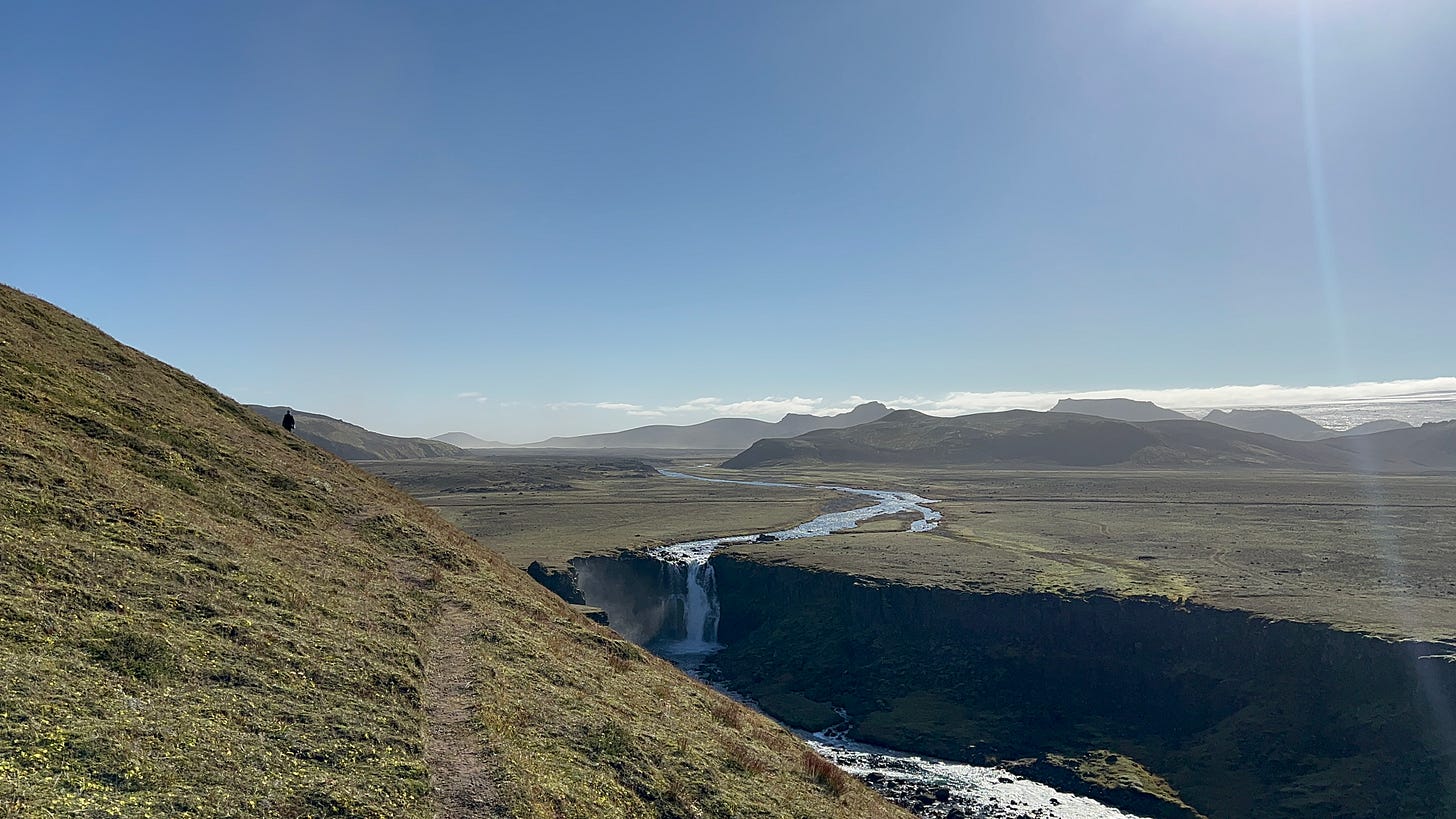
When we finished the loop, we picked up our packs and made our way to Emstrur hut, which began with crossing the river that we had seen others fording earlier. Like all glacial-fed rivers, this river was f*ing cold. It was also knee deep and just wide enough to make it challenging to pass swiftly. My body does not tolerate cold water. Even after spending years living between Lake Washington and the Puget Sound, it does not take that cool of water to feel like it’s cutting through my bones. I hate this. I hate that something makes me so physically uncomfortable that it becomes an obstacle in my path. That’s the reason why I came to Iceland in the first place. Mid-flight panic attacks prevented me from ever considering leaving the country so I chose a country with a short flight path. There is always a path forward unless you choose to stay put.
Like easing myself into international travel, I’ve been easing myself into cold water by practicing cold plunges but have learned that it will never feel more comfortable. It will always hurt. Clenching my muscles, swearing, tightening my joints- none of it helps like I once thought it did. Bracing for impact makes the impact harder. So just like I chose to go to Iceland feeling blind, I chose to walk into the river blindly. As quickly as possible I took off my boots, stripped off my socks, rolled up my fleece-lined leggings and rain pants, released all the tension in my body, and walked across the river singing knee deep in the passenger seat and…. I’d continue but my mom is reading this along with you.
And it was fine. I couldn’t tell you what the water felt like. Cold, obviously. But I chose to relax my muscles and “embrace the suck”. The only challenge of passing was the last three steps when my feet were so numb from the water that they weighed me down like bricks of ice.
Done. Between the hot springs, melting ice caves, and knee-deep river crossing, every day seemed to start with a cleanse.
From the river continued our multi-mile trek through a black-lava covered basin whose width seemed to stretch for at least a mile. Yesterday we stood at the ridge of the caldera peeking into the basin. Today we stood in it, sunk into the landscape that had been carved out by eruptions, glacial melt, and tectonic movements. There was nothing in front us for miles aside from the moss-covered ridges and cones far in the distance on either side of the trail. A hike like this could easily suck. Miles of flat, black emptiness. I don’t do well with “suck”, so today seemed like a good day to ration some battery life to listen to Sigur Rós.
As the piano notes of Ara Batur slowly built, the details of the landscape assembled themselves. Life was so precious here yet resilient. It was persistent to live yet vulnerable to any change. Some of the changes in this landscape occurred suddenly. Lahars and eruptions caused immediate destruction that eventually allowed new life to find a way. Between eruptions, slow changes in the landscape allowed life to adapt slowly with it. With enough time and persistence, a trickling stream deepened a valley. Wind turned rock into sand. Vegetation settled their roots into softened rock. The insulation of moss allowed other grasses and shrubs to grow. Life itself was determined, and like the lava from a volcano, it transformed simply based on what was in front of it. It had no clear path nor plans other than to live. Life existed simply to live and would continue to do so regardless of it’s form.
The trail that was once an empty black basin somewhat cleared by footprints suddenly became lined with small lava rocks. Larissa continued on behind me. Other parties at least half a mile in front of us had broken up as well. We walked at different paces yet on the same path. I could not see the full distance except for what was right in front of me. I could see others in the distance but could not see the path they walked on despite knowing it was the same one. My quads weakened. Jónsi Birgisson’s voice rose with keys of the piano. I couldn’t keep walking. I felt like I could fall right there in the middle of the lava desert. Larissa passed me as I bawled, slowly spinning to take in everything that created the walls lining the basin. Hundreds of miles of glacier(s), large mountain ridges and peaks, the southern wall of the caldera, Stórasúla and the other peaks that once connected to it. Had I sunk into the basin, or had the basin sunk into me?
In order to exist, life cycles between movement and rest. Lava, glacial ice, water, crust, moss, flowers. It all rested in one place to live and moved when it was ready to give life. I continued walking, tears streaming down my face as brisk wind wiped them away. Every path felt like part of a bigger journey. Life itself was so big and I was so small. It was passed on to me and I continue to pass it on. I could not see the path forward, yet it had already been determined for me. My direction would divert when I hit a hard spot. My pace would accelerate when I hit a weak one. I could not predict what life would be created along the way but I could be sure that it would be created as long as I continued to move forward.
When we reached Emstrur hut, Ellen cheerfully greeted me as we reflected on the hike. She said that she had listened to a podcast that called the section from Hvanngil to Emstrur the “Day of Reflection”. As each party arrived, I passed on this information and each person shared their reflections. Some reflected on past choices. Some on changes they wanted to make in their lives. Some let their minds wander and did not think about anything at all. Regardless, the basin had forced us to sink into ourselves. Up until now, I thought each human was an individual when we are actually all one. In the bathroom stall (yes, bathroom!), someone had carved into the door “do you remember who you are?” Even those who hiked before us had felt the journey designed by the trail.
Pascal shared that he felt bad for being lost in his thoughts and not taking in everything around him. Mattia reminded us that our environment impacts us whether we are conscious of it or not. We were all different people, yet many of us had the same thoughts on trail in the same places. Many of us paused in the same spots. Noticed similar details in the landscape. I’m an avid hiker who adores the outdoors but never understood those who had a “spiritual awakening” on a hike. I was embarrassed to admit that I now understood them. After today, I felt transformed. Others admitted the same. I asked how everyone had planned to keep the Laugavegur with them in real life. How could I practice what it had given me when it took 3 full days on trail to notice? Mattia said to do things that are scary as much as possible. I said I do and now I’m bored. He said to do what I did as a child. I said I do. He said “Do them as if you were a child.”
Intention is important, so I started recording the journey in order to keep the Laugavegur with me deliberately. But as Mattia said, our environment impacts us in ways we cannot always see. Just like the wind picks up pollen as it sweeps past a flower, I can trust that I’ll carry along whatever the Laugavegur gave to me.
This day could have been terrible. I could have fought to pass the river or let miles of a flat barren path get to me. But instead I chose awe. Another etching in a bathroom stall read, “Everywhere you go take the weather with you.” I’ve never taken so many pictures of lavatory graffiti.
In the evening, we went on a hike to a nearby canyon. The hillside leading to the canyon was black like the lava basin, but instead of being hard and flat it was so soft our feet sunk into it. Eventually we arrived to the canyon that had carved through millions of years of rock. Red, black, tan, and brown layers lined the canyon in flat lines, swirls, and waves. Some had expanded and compressed, telling us how their paths had changed. Mist carved out protected caves and we debated which white lines in front of them were icicles and which were waterfalls. Moss lined the South West side of the wall. Mýrdalsjökull took up at least half of the sky, reflecting shades of blue, pink, orange, and yellow as the sun set. A green mountain stood on the West side of the canyon. Despite being thousands of miles away and having an opposing climate, it reminded me of the mountains in Kauai. We’re all made of the same stuff, aren’t we?
We had not seen birds until today, and only saw a small flock of them. Yet on the hillside we stumbled upon 3 feathers. Iona ran along the hillside kicking up black dust with cartwheels. I thought I was free. But was my child always free within me?
At Hvanngil hut, I saw the Northern Lights for the first time. But at Emstrur they took up the entire sky. I can’t explain how wonderful they were. It will take me awhile to put into words. Large ribbons, waves, roads, and curtains of white illuminated the sky. A picture or video cannot make you understand their awe. The naked eye could make out little patches of green and pink, but the general absence of color did not make them any less wonderful. At times, the waves and curtains danced. But when they were directly above our heads we could not make out where they began or ended. Instead they dropped above us like a stream from a showerhead, cleansing us before turning in for the night.
DAY 4 - THOR’S GOODBYE / REFORESTATION
On the final day of the trek, we hiked 10 miles from Emstrur into Þórsmörk, otherwise known as “Thor’s Valley” or “Thor’s Forest”. Snow that eventually turned into rain followed us on our journey, as vegetation swallowed the black and brown earth underneath. Crowberry and blueberry shrubs nuzzled themselves between patches of moss. Larissa and I questioned as to whether or not anyone else had noticed the abundance of edible fruit, yet hesitated to pick them ourselves since our hands were already freezing.
Once we hit mile 6, the rain cleared up and the storm remained behind us. We gasped with amusement at a spider - the first insect we saw on trail - and wondered if we would find any other signs of life. Shrubs transitioned into trees and eventually a section of the trail passed through a clearly organized patch of seedlings strung evenly into waves. Later we learned that Thor’s Forest had suffered from deforestation and overgrazing and recent projects were under way to reforest the land. The self-centered human brain distorts our perception of “abundance”.
Eventually we made our last obvious ascent up a hill that was overgrown in shrubs, berries, and birch trees. We could no longer see the valleys, basins, mountain cones, ridges, or glaciers behind us. The only path we could see was just a few feet in front of us. After having days of endless visibility, we questioned multiple times whether we were going the right way. We had cell service, trail signs, and blue-tipped posts every few hundred feet yet were still unsure if we were on our way to the right hut.
Once in Þórsmörk, we rested for a few hours until picking up our bus back to Reykjavík. Larissa had mentioned how much more we see when hiking instead of driving. On the drive out from Þórsmörk, we had seen so much of the landscape as it changed. Ridges broken by the weight of glaciers. Valleys carved by lahars and glacial melt. But in a vehicle we couldn’t see the fingers of moss that resembled alveoli. Nor the berries that grew on shrubs between the moss, or rogue strands of grass determined to reproduce. We couldn’t see the mist that carved caves into the earths crust after it had been exposed by tectonic activity. Nor could we see the gentle streams that will one day carve out rocks, nor the pebbles at the bottom of a valley that once rested atop a mountain side. We would have never known that between the narrow valleys of each barren mountainside live moss, algae, streams, volcanic vents, and the occasional bell-shaped flower. We would have never known that on the other end of the abyss is life if we had not chosen to walk right through it.
To go in the dark with a light is to know the light. To know the dark, go dark. Go without sight, and find that the dark, too, blooms and sings, and is traveled by dark feet and dark wings. - Wendell Berry





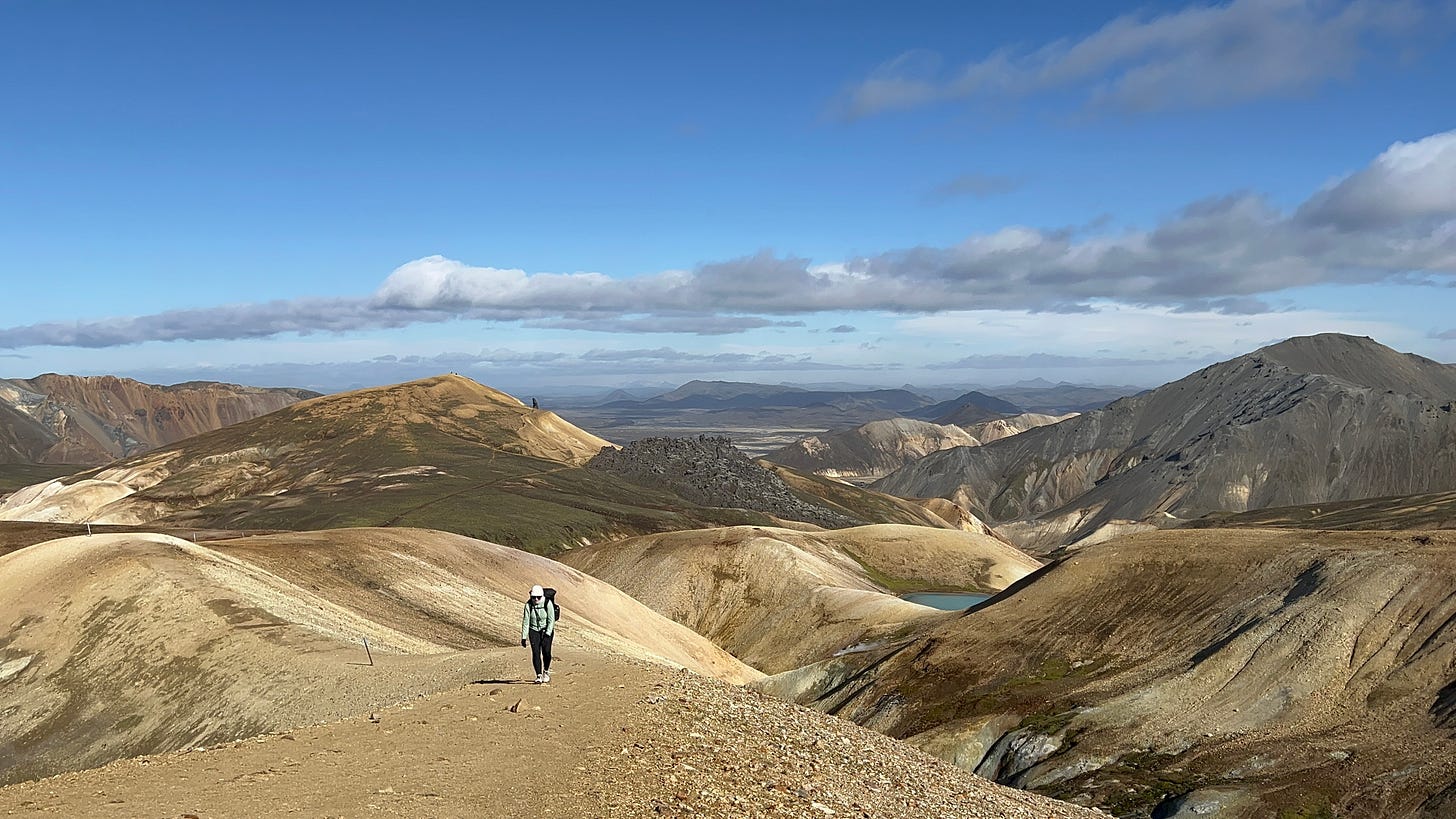
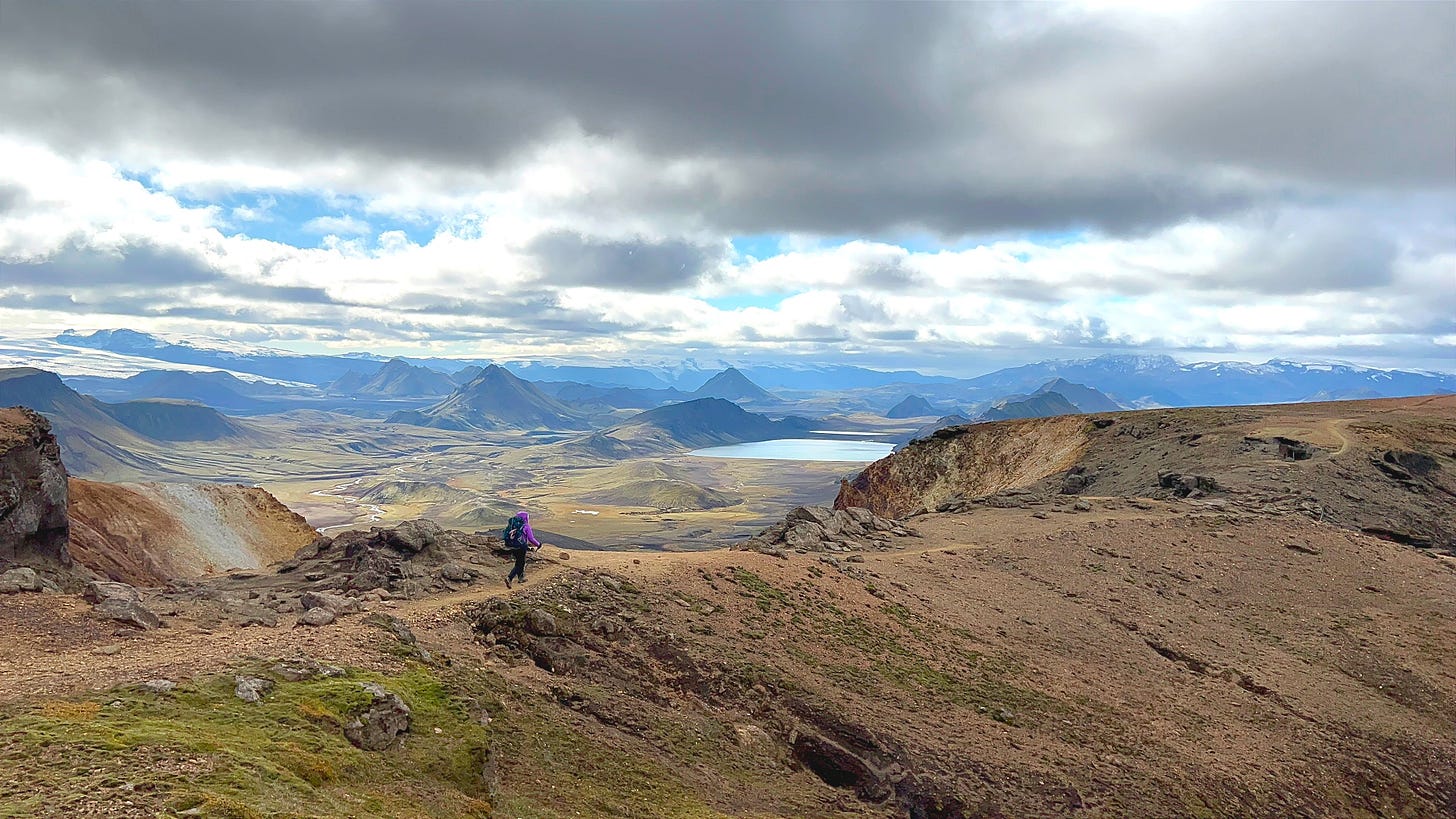
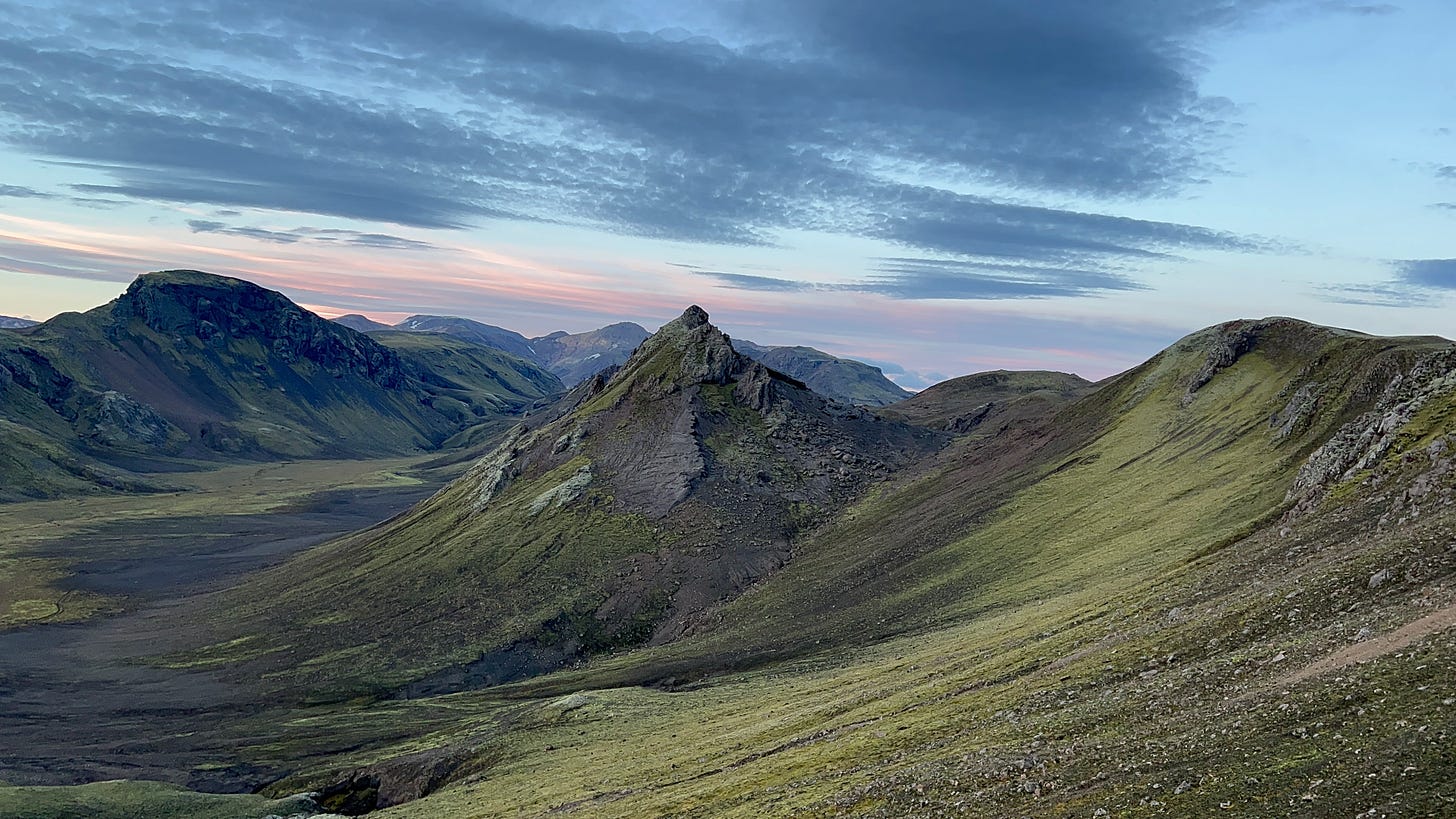

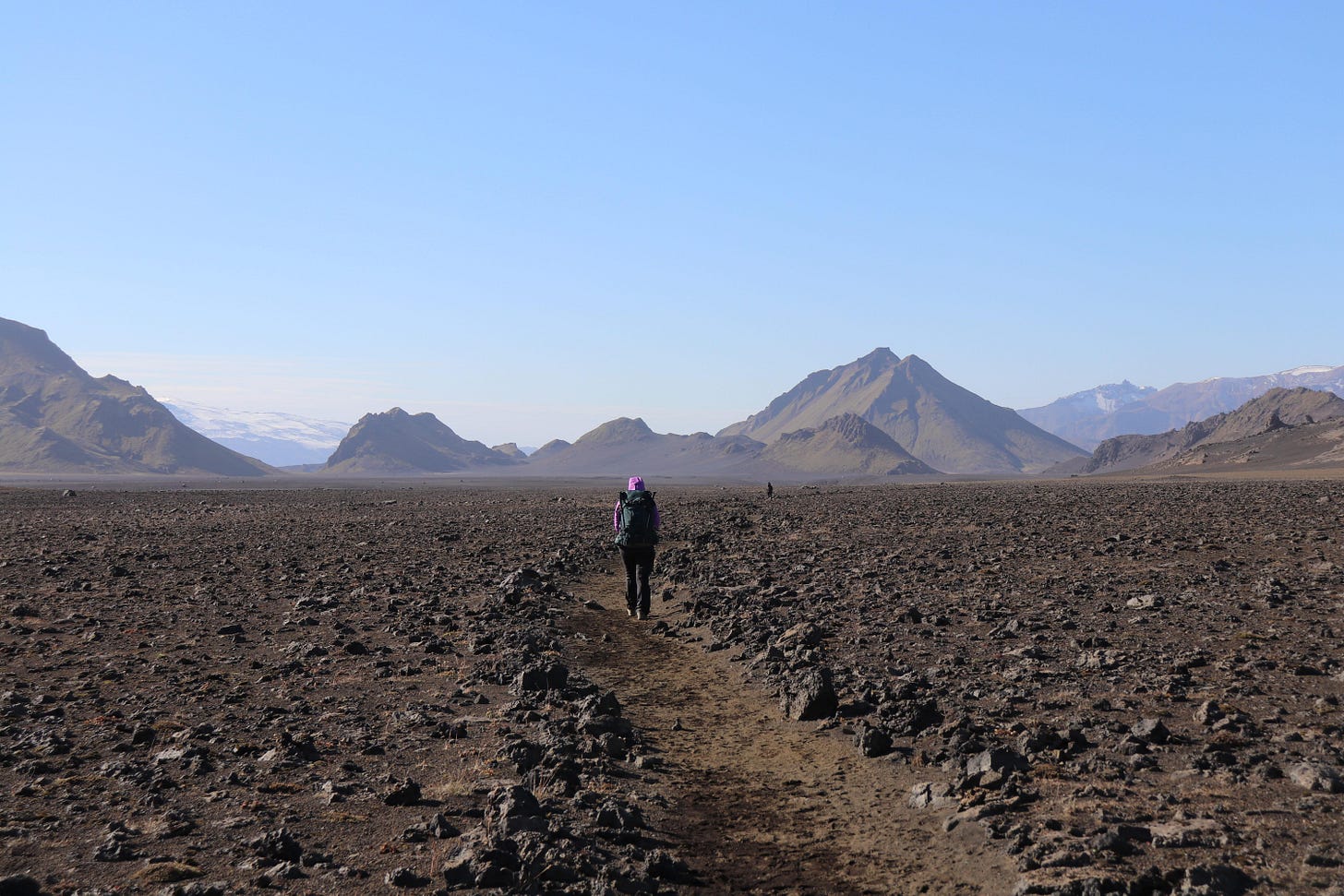
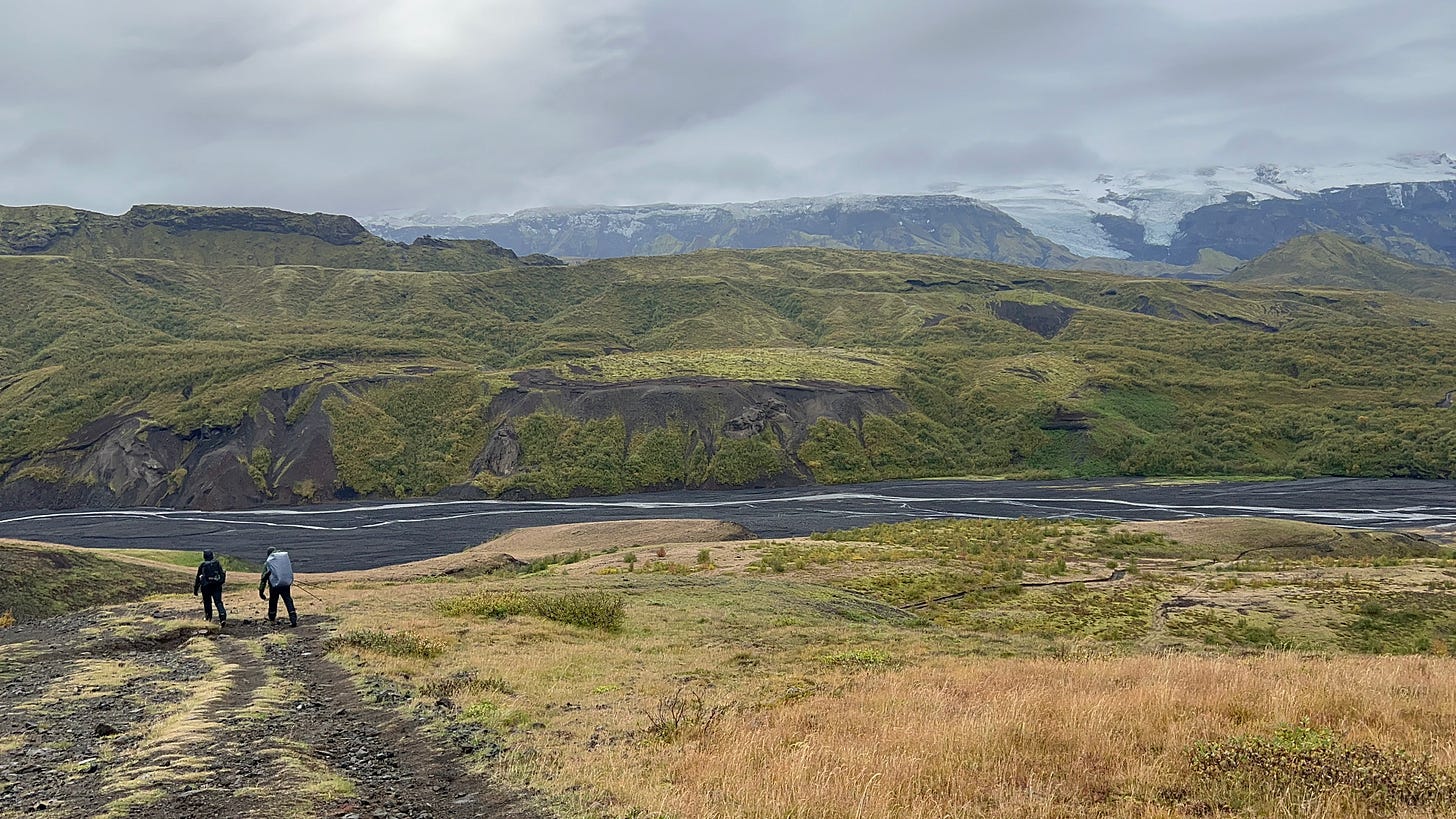
Thank you Stephanie for your very thoughtful post and the many details that i didn’t noticed consciously during the trail but some of those things i could perceive retroactively out of my unconcsious mind :) I was also crying in the desert and when i was reading your post. Pascal